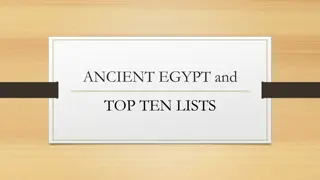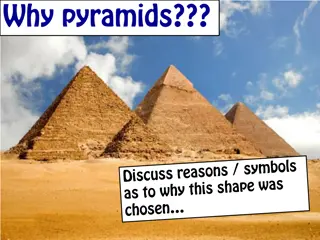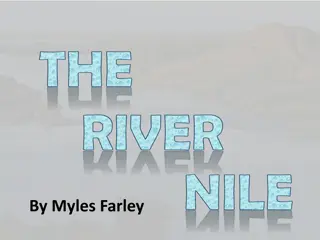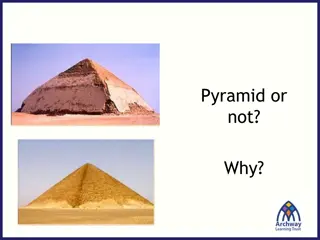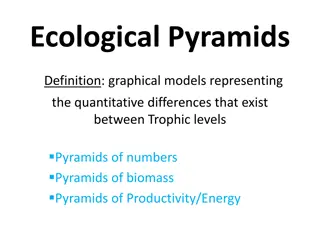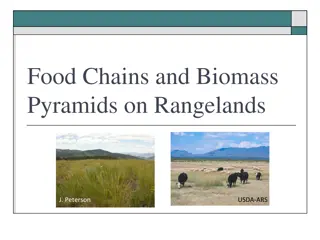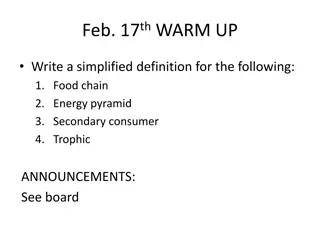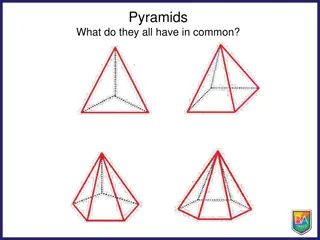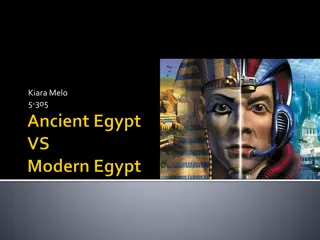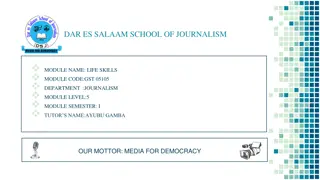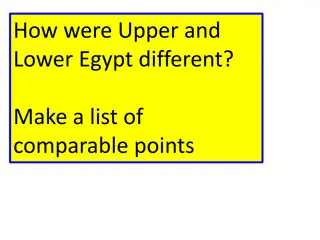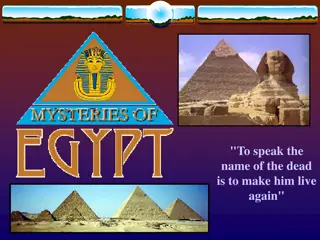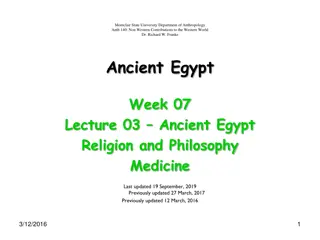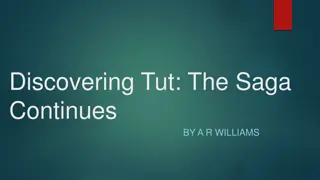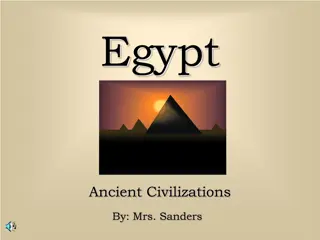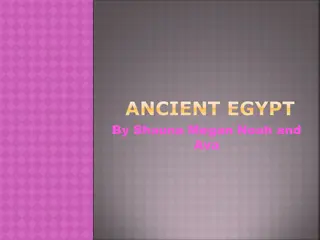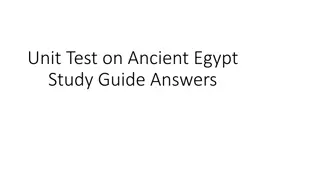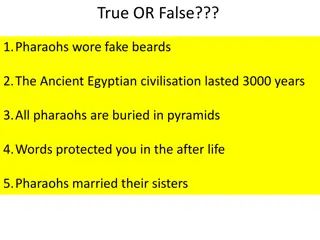Ancient Egypt: Unveiling the Mysteries of the Pyramids
Delve into the wonders of Ancient Egypt as we explore the Pyramids, Tomb Hieroglyphics, and more in this non-chronological report. Learn about the use of adverbials, relative clauses, and parentheses to enhance the richness of the narrative. Unravel the secrets of the Great Pyramid and its intricate designs, all set against the backdrop of a civilization shrouded in mystique.
Download Presentation

Please find below an Image/Link to download the presentation.
The content on the website is provided AS IS for your information and personal use only. It may not be sold, licensed, or shared on other websites without obtaining consent from the author.If you encounter any issues during the download, it is possible that the publisher has removed the file from their server.
You are allowed to download the files provided on this website for personal or commercial use, subject to the condition that they are used lawfully. All files are the property of their respective owners.
The content on the website is provided AS IS for your information and personal use only. It may not be sold, licensed, or shared on other websites without obtaining consent from the author.
E N D
Presentation Transcript
A little trickier - using the skill in a more complex sentence Tricky! Using the skill in a complex sentence, with other skills GDS Non-Chronological Report Skills used in a Non-chronological report: - Topic based vocabulary - Headings and subheadings - Key facts and information - Adverbials - Parenthesis to add extra information - Relative clauses Lesson 2 In this lesson you will complete the subheadings: The Pyramids of Ancient Egypt The Tomb Hieroglyphics
Adverbials Recap the skills we will be using: An adverbial is a word or phrase that has been used like an adverb to add detail or further information to a verb. Interestingly, the Pyramids of Giza are sloped just slightly, one of the many magical creations of the Ancient Egyptians The adverbial interestingly has been used at the beginning of the sentence. Adverbial examples for a non chronological report Surprisingly, interestingly, clearly, in addition, as well as this, amazingly, strangely enough, Interestingly, the Pyramids of Giza are sloped just slightly, one of the many magical creations of the Ancient Egyptians - strangely this cannot be seen with the naked eye. Two examples of adverbial have been used to add detail. Parenthesis has also been used. The Pyramids are without a doubt one of the most incredible feats of man in the world. It is no surprise that they are one of the 7 wonders of the world. Two examples of adverbials have been used. One in the middle of a sentence and one as a fronted adverbial.
Relative clauses Recap the skills we will be using: Relative clauses add more information to a noun in a sentence. They often use relative pronouns. Who, which and that are the most common relative pronouns. The Great Pyramid, which is located in Cairo (in Egypt), is visited by millions of tourists a year. Relative clause is embedded and adds detail to the noun The Great Pyramid. From afar the Pyramids, that are positioned behind the Sphinx, seem as though they are smooth. However, they are made from large stones, which would have been hand made by the Ancient Egyptians. A relative clause is used to describe the Pyramid, and the large stones in 2 separate relative clauses. Many deserts around Egypt, ranging as far as Sharm El Sheikh, have various smaller pyramids that are designed in different ways but are not as large as the Great Pyramids. One relative clause has the pronoun omitted. There is also a relative clause at the end of a sentence.
Parenthesis Recap the skills we will be using: Parenthesis is a word, phrase, or clause inserted into a sentence to add extra, subordinate or clarifying information. When a parenthesis is removed, the sentence still makes sense on its own. Although the Pyramids are incredibly famous world-wide, the Sphinx (located next to the Pyramids) is also revered for its magnificent feat of engineering. Brackets have been used to add information about the pyramids. Punctuation for parenthesis - Brackets - Commas - Dashes The Great Pyramids (one of the 7 wonders of the world) are located in Giza, which is in Egypt s capital city - Cairo. Brackets have been used to add information about the Pyramids, and a dash to add further detail about the location.. The Great Pyramids are (funnily enough) shaped like a triangle based prism - they are known to preserve the bodies of mummies so well that they are still being discovered up to today! Brackets have been used to add additional information, and humour has been used to engage the reader. Also a dash has been used to add additional information.
On the document attached, now take your notes that you made, and turn it into the full paragraph about the two subheadings: The pyramids of Ancient Egypt The Tombs https://docs.google.com/do cument/d/1c_3iTor9Pz5kX1 _bo4-q-I8RREzNe- 6W4xfcEbbNRX4/edit
Planning and writing task document Complete your paragraphs either on a piece of paper, or by making a copy of the google doc (link below) and typing your ideas on. This final lesson will expand your final 2 subheadings into full paragraphs. https://docs.google.com/document/d/1c_3iTor9Pz5kX1_bo4- q-I8RREzNe-6W4xfcEbbNRX4/edit
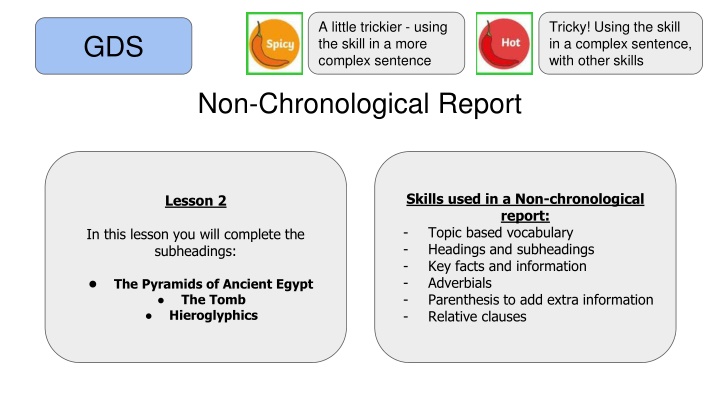

![[PDF⚡READ❤ONLINE] Tutankhamun's Trumpet: Ancient Egypt in 100 Objects from the](/thumb/20549/pdf-read-online-tutankhamun-s-trumpet-ancient-egypt-in-100-objects-from-the.jpg)
